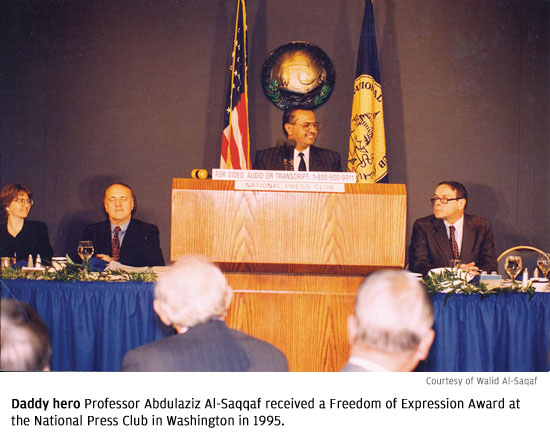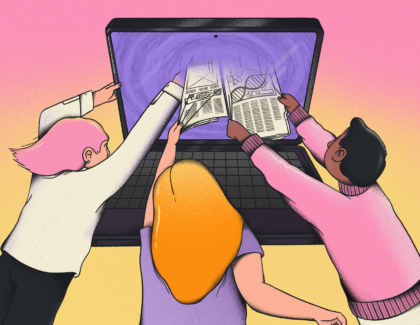Sign up for the daily CJR newsletter.

January 26, 2011, was just another cold winter day in Sweden, where I attend graduate school. I returned to my office from a coffee break to dozens of e-mails saying that the websites of Facebook and Twitter had been blocked in Egypt, apparently in response to massive demonstrations the day before in Tahrir Square, calling for the end of Hosni Mubarak’s regime. The activists there desperately needed a way to bypass censorship. I sat down at my computer and did my best to get the word out about software programs that would help them, including my own.
This was a long way from where I began, but in a sense, I’d also come full circle. When I graduated from Middle East Technical University in Ankara in 1998 I’d returned home to Yemen, eager to start a career as a software developer. But my father had other plans for me.
The man others referred to as Professor Abdulaziz Al-Saqqaf (1952-1999) had just marked the eighth anniversary of his founding of the Yemen Times, the country’s first English-language newspaper. He launched the paper the same year North and South Yemen joined to form a single country, led by the fearsome Ali Abdullah Saleh, a Saddam Hussein crony who was the longtime leader of the north.
My father and I did not have much in common. A Harvard alumnus, my dad had remarkable communication skills and a vast network of contacts across the globe; I wasn’t very sociable. He courageously exposed corruption and injustice, while I tended to distance myself from politics. As much as I hate to admit it, I was scared of confronting anyone in uniform. I did admire his bravery—yet I also felt he was constantly putting himself and the paper at risk. I was selfishly set on a career in Silicon Valley, while he was struggling to help his people.
I respected my dad’s love for journalism, but to me, it seemed boring, dull, and low-paying. One night, he suggested I work beside him in the Yemen Times editorial department for a year. I remember storming out, saying, “Sorry, Dad, I can’t do it!” But after a chat with my mother, I apologized and agreed to be an assistant editor and network administrator—at least until October 1999, when I would be leaving for the US to study computer engineering. I thought to myself, Why not just help Dad out? After all, it’s just temporary. Or at least that’s what I thought.
A change in priorities
On June 2, 1999, I got the news that after leaving a lunch meeting with Abubakr Al-Qirbi (now foreign minister) and others, my father had been hit by a speeding Mercedes on Hadda Street in Sana’a, the Yemeni capital. I had always seen him as strong and invincible, refusing to back down from even the most ruthless political foes, including President Saleh, who had threatened him on more than one occasion. Seeing his body in the morgue was simply unbearable.
Being the eldest son, I had to take charge of the family business, and so I became the editor in chief and publisher of Yemen Times at the age of 26. A few weeks after my father’s death, a letter arrived that he’d been anxiously waiting for: I had been granted a Fulbright scholarship to study at the University of California, Davis. I asked for a one-year deferment.
A year later, still clinging to my personal dream, I left the newspaper in the hands of my sister, Nadia, who had since graduated from college, and my mother, an English-language teacher, and set off for UC Davis with my pregnant wife to start my graduate work. But then came the second shock: Just three months later, in December 2000, my mother died of a brain hemorrhage. Despite my protestations of independence, I did not hesitate to return home. I realized it was my destiny to resume the journalism career that I tried to avoid so desperately. I had to surrender to my fate and say farewell to my Silicon Valley ambitions.
Fast forwarding to 2005, I confess that I am glad I did. It was a steep learning curve, but I realized why my father loved what he was doing: It was because of the inner satisfaction one gets from giving people a voice, exposing injustice, and promoting human values. Those were things that a geek behind a keyboard could not have done.
While editing the paper, I faced no direct censorship. But there was constant self-censorship, due to the strict press laws. Many topics involving religion, the military, foreign relations, and government officials were taboo.
After six years at the helm of Yemen Times, it was time for another international challenge. I handed the paper back to my sister, Nadia (who had just completed her master’s degree), and plunged into a five-month Alfred Friendly Press Fellowship program in The Wall Street Journal’s Washington, DC, bureau. I interviewed high-profile political figures, participated in major conferences, observed voting sessions and debates in Congress, and even made it inside the White House press room. It was a thrilling experience.
When I finally got around to my graduate study, it was in journalism, not computer science—and I knew I would eventually head back to Yemen to share what I’d learned. While pursuing a master’s in global journalism at Orebro University in Sweden, I continued to write articles for the Yemen Times and occasionally the Dubai-based Gulf News. A year into the program, I was asked to do a media project for a course and realized I could perhaps start a news-related website.
Another door opens
I remember vividly the day in 2006 when I stood up and wrote the words “Yemen Portal” on the white board. Immediately, I sensed curiosity and interest from my classmates. I said I thought it was time for someone to build a multilingual search engine that could aggregate news and opinion on Yemen from dozens of news websites and present the information in a clear and readable manner. Little did I know that Yemen Portal would mark another turning point in my life.
Within six months, Yemen Portal featured tens of thousands of articles from dozens of sources and was among the top websites in Yemen. In late 2007, I returned home to do focus groups for my master’s thesis. Observing Web traffic patterns, I had noted that news from dissident sites was more popular than stories from government sources. Indeed, since the site’s presentation gives priority to the stories that are the most read and commented upon, Yemen Portal clearly showed widespread interest in articles that were extremely critical of the state and of President Saleh. I discussed this openly during the focus groups and then, while I was still in Yemen, something truly awful happened.
On January 19, 2008, Yemen Portal went dark. I tried various computers, but all returned the same “Server timeout” error message. I frantically called a friend in Sweden to check the site. He said it was opening fine at his end. I realized then that my website has been censored.
I called the Internet Service Provider (ISP), which is state-owned, but got nowhere. I later confirmed that government operatives had blocked the site inside Yemen, claiming it was a security risk since it contained inflammatory anti-Saleh content. Looking back to the traffic logs a few days before the website was censored, I found a spike in readership on January 13, which I could trace to several articles and video links on an anti-government protest in the southern city of Aden as well as articles about a subsequent attack that killed some protestors. It seemed that readers were turning to my website for news about the protest, so the regime decided to make it inaccessible inside Yemen.
Frustrated by this injustice, I rallied other website administrators, and together we launched a nationwide protest against censorship—it turned out Yemen Portal was not the only website being blocked by the authorities. The campaign was covered by the Swedish newspaper Nerikes Allehanda but had little result.
Still, I knew there was another way: Over the next few weeks, I developed software that would allow users to access Yemen Portal—and all the other blocked sites—via a Web-based proxy. My actions did not go unnoticed; my car in Sana’a was vandalized, but by that time I had already returned to Sweden. I realized that the regime was willing to take violent action against me, but I refused to surrender to government blackmail.
Calling upon connections I had made while editing Yemen Times, I was able to draw attention to the regime’s repressive practices, with help from a number of organizations such as the World Association of Newspapers, Reporters Sans Frontiers, Article 19, and the Committee to Protect Bloggers.
A way around censorship
In 2009, as my cyber war with the Yemeni authorities intensified, I released a software solution named Alkasir (which means “the circumventor” in Arabic). I built it as a research tool for my PhD study on Internet censorship, but it has turned out to be useful to activists as well. The Alkasir software provides access to blocked websites anywhere in the world through an alternative tunnel that is encrypted. The Internet Service Provider cannot detect which blocked websites an Alkasir user is seeing, because traffic to and from censored websites goes through a tunnel to the proxy, which in turn retrieves the site’s content and delivers it to the user dynamically. Alkasir also helps users avoid detection, because it tunnels only blocked websites, while letting nonblocked content flow directly through the regular ISP.
While working on Alkasir, I stayed in touch with activists in Yemen and started to develop connections throughout the Arab world. Several wrote me from Tunisia, explaining how they used the software to circumvent censorship and upload content to websites that were blocked. I spread the word on alkasir.com.
As the world now knows, the activists were able to get their message out; the protests that followed the self-immolation of Mohamed Bouazizi triggered the Tunisian revolution, which led to the downfall of Zine El Abidine Ben Ali.
A few weeks after the Tunisian uprising, on January 25, 2011, more than 1 million angry Egyptians filled the streets of Cairo, mobilized via social networking websites such as Facebook and Twitter. The next day, Egyptian authorities resorted to censoring social sites and jamming mobile network traffic. A Twitter search for the phrase “#jan25 proxy” on January 26 shows that many users were sharing information about censor circumvention tools, and I did what I could to help—via Facebook, Twitter, and e-mail both to mailing lists and to fellow Arab activists. Alkasir traffic spiked. Activist Ahmed Zidan later said in a CNN interview how important Alkasir was for him and others to retain access to social networking websites that proved crucial in the Egyptian revolution.
My contribution was modest, compared to the sacrifices made by those on the scene. Nonetheless, I feel a sense of satisfaction in knowing that I was able to help the Arab Spring protesters access the Internet and publish content during the uprising. Meanwhile, closer to home, in February of this year longtime Yemeni president Ali Abdullah Saleh, my late father’s nemesis, finally stepped down.
As my dad taught me, access to information is power. I am confident that if he were alive today, he would have supported the Arab youth struggle for freedom and helped integrate technology into the newsroom to support a free and open flow of information to the public.
There is a lot yet to be done before the Arab world is free from tyranny and oppression. Cyber censorship remains in Syria, Iran, China, and other countries. It has become vital for activists to access blocked content. I hope my father would be proud that my software now has tens of thousands of users in countries struggling with online censorship. I dedicate all my work to his memory.
Has America ever needed a media defender more than now? Help us by joining CJR today.






